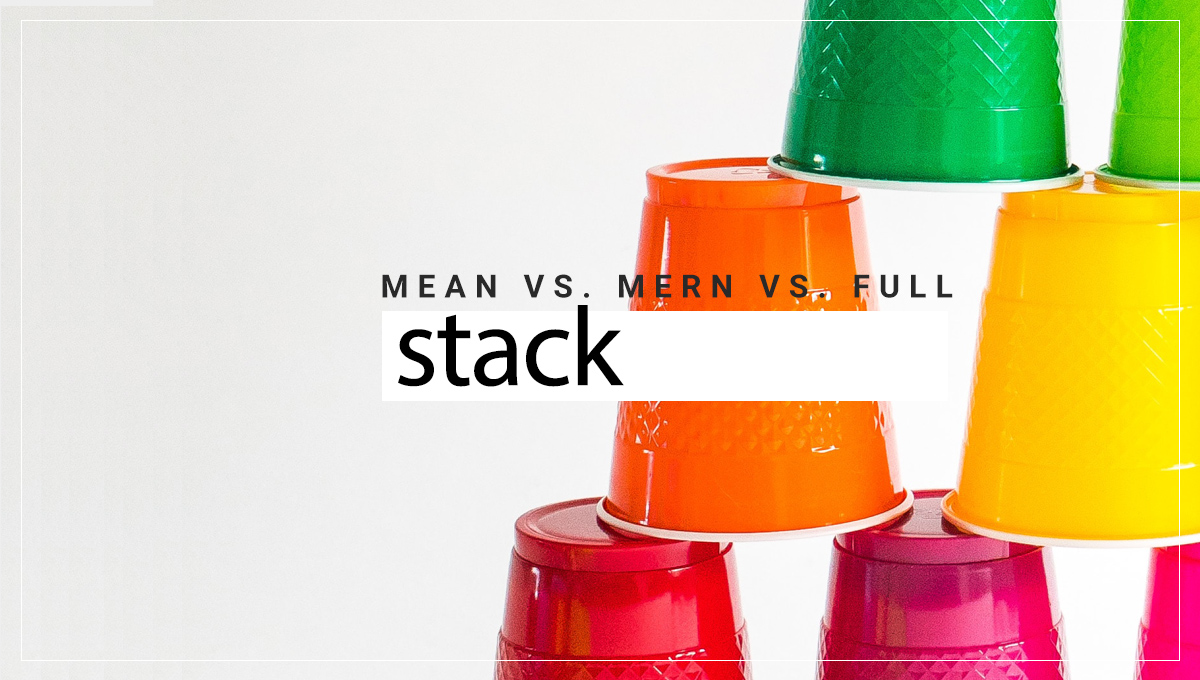Are you confused about which technology stack to choose for your next web development project? Don’t worry; we’ve got you covered! In this article, we will delve into the world of Full Stack, MEAN Stack, and MERN Stack development and help you understand the differences between them. Whether you are a seasoned developer or a newbie, this article will provide insights on each stack’s pros and cons and help you make an informed decision for your next project. So, let’s dive in and explore the world of web development stacks!
What is Stack
In web development, a stack refers to a collection of programming languages, tools, and frameworks used to build a web application. The term “stack” typically refers to the layers of technology that are involved in building and running an application, including the frontend, backend, database, and server infrastructure. Different stacks can vary widely in terms of their components, and the choice of stack can significantly impact the performance, scalability, and maintainability of a web application.
You May Also Like: What is Single Page Applicaiton

Things to consider before Choosing the Best Stack for your next project
You must consider the following before selecting the appropriate stack:
- The scope of your project and the requirements that must be met.
- Does it require agile development?
- What are you hoping to accomplish with this project, and how do you intend to get it done?
- How skilled is your team?
- Is it possible to scale up or adapt your development team to accommodate the requirements of the project?
- What is the rough estimate of the costs associated with the project?
Figuring these things out will help you decide whether to go with Full stack, MEAN stack, or MERN stack.
Let’s take a closer look at them
What is Full Stack Development
Full stack development is the practice of building both the frontend and backend components of a web application using a comprehensive set of technologies and frameworks. In other words, a full-stack developer has the knowledge and skills to handle all aspects of web development, including user interface design, server-side programming, database management, and deployment.
The frontend component of a web application includes everything that users see and interact with, such as the user interface, layout, and design. It typically involves using languages such as HTML, CSS, and JavaScript, along with frameworks like React, Angular, and Vue.js, to create responsive and visually appealing web pages that work across multiple devices.
On the backend, developers use programming languages such as Python, Ruby, Java, or JavaScript, along with frameworks such as Node.js, Django, Ruby on Rails, or Spring Boot, to build the logic and functionality of the application. This can include managing data storage and retrieval, handling user input and authentication, and integrating with external services or APIs.
In addition to these technologies, full-stack developers often use databases such as MySQL, MongoDB, or PostgreSQL, and deployment tools such as Docker or AWS to deploy and manage their applications.
You May Also Like: What is Progressive Web Application
Benefits of Full Stack Development
There are several benefits of full-stack development. Some of the key benefits are:
- Versatility: Full-stack developers have a broad range of skills that enable them to work on all aspects of web development, from the front end to the back end. This versatility can be a significant advantage, especially for small and medium-sized businesses that require developers who can handle multiple tasks.
- Greater control: Full-stack developers have complete control over the entire development process, from design to deployment. This can lead to faster development times, better quality control, and a more streamlined workflow.
- Cost-effectiveness: Hiring a full-stack developer can be more cost-effective than hiring separate frontend and back-end developers. With a full-stack developer, you can get all the skills you need in one person, which saves time and money in the long run.
- Faster problem-solving: Full-stack developers have a deep understanding of all the components of a web application, which makes it easier for them to identify and solve problems quickly. This can help to minimize downtime and ensure that your application runs smoothly.
- Improved communication: Because full-stack developers are familiar with all aspects of web development, they can communicate more effectively with other members of the development team, such as designers and project managers. This can lead to better collaboration, more efficient workflows, and better results.
You May Like: What is Full Site Editing
What is MEAN Stack Development
MEAN stack development is a web development framework that utilizes a combination of four technologies: MongoDB, Express.js, AngularJS, and Node.js. MEAN is an acronym for the first letter of each of these technologies.
MongoDB is a NoSQL database that uses JSON-like documents to store data. It provides a scalable and flexible data storage solution that can handle large amounts of data.
Express.js is a backend web framework for Node.js that provides a set of tools for building web applications and APIs. It is lightweight and flexible, making it easy to build and maintain web applications.
AngularJS is a front-end JavaScript framework developed by Google that allows developers to build dynamic and interactive user interfaces. It provides a set of tools for creating reusable components, handling user input, and managing data.
Node.js is a cross-platform, open-source, backend JavaScript runtime environment allowing developers to build scalable, high-performance web applications. It provides a set of built-in modules that make it easy to handle tasks such as file I/O, networking, and server-side rendering.
Together, these four technologies form the MEAN stack, a powerful and flexible web development framework that allows developers to build full-stack web applications using only JavaScript.
You May Love To Read: How To Make A WordPress Website?
Benefits of MEAN Stack Development
- MEAN extensively uses JSON, which significantly simplifies the developer’s work. JSON is easy to read and understand, and it is also easy to work with. This means that MEAN is far less expensive than other web development frameworks.
- In addition, MEAN is compatible with the cloud and Open Source, making it an excellent option for businesses seeking to reduce their web development expenses.
- The MEAN stack is completely JavaScript-based on both the client and server sides. This means it is isomorphic by design, allowing for speedy application development and deployment. It also eliminates the need to hire separate backend and frontend development teams. You may build a whole application with the same team, reducing development costs and saving time.
MEAN is an excellent choice if you’re seeking a framework for web development that is simple to learn and use.
What is MERN Stack Development
MERN stack development is a full-stack web development framework that combines four technologies: MongoDB, Express.js, React, and Node.js. The name “MERN” is derived from the first letter of these four technologies.
We have already discussed MongoDB, Express.Js, and Node.js in the MEAN stack Development. The only thing differentiating the MERN stack from MEAN Stack is that React is used instead of Angular.
React is a popular front-end JavaScript library developed by Facebook that allows developers to build dynamic and interactive user interfaces. It provides tools for creating reusable components, handling user input, and managing data.
Together, these four technologies form the MERN stack.
You May Like: Best Blog Hosting Sites
Benefits of MERN Stack Development
- Because of React’s virtual DOM, the MERN stack can render user interfaces quickly. As React is a library and not a framework, you have more leeway in structuring and optimizing your code for maximum efficiency. In turn, this boosts user satisfaction and makes your web app more search engine optimised.
- MERN stack is easy to set up and has excellent community support.
- React paves the way for enterprises to create powerful hybrid mobile apps with the help of the React Native framework. This framework is focused solely on mobile application development. This allows for functionality such as camera access and automatic data synchronization between the app’s online and offline modes.
However, developers must be proficient in JavaScript and JSON in order to use the MERN stack efficiently.
MEAN Stack or MERN Stack (Which One to Choose)
It might be difficult for someone to choose between both the stacks as both MERN and MEAN stacks are popular web development stacks that use open-source JavaScript-based technologies, but there are some unique benefits of using each stack which is quite necessary to know.
Benefits of MEAN Stack, which sets it apart from MERN Stack
- Easy to Learn: The MEAN stack is relatively easier to learn than the MERN stack because AngularJS is easier to learn than React. AngularJS has a more comprehensive set of documentation, which makes it easier for developers to get started with the framework.
- Two-Way Data Binding: AngularJS, which is used in the MEAN stack, provides two-way data binding. This means that changes made to the model are immediately reflected in the view and vice versa. This makes it easier for developers to manage data flow in their applications.
- Stronger MVC Architecture: The MEAN stack’s use of AngularJS provides a more robust Model-View-Controller (MVC) architecture than React. AngularJS provides a more structured approach to building web applications, which makes it easier to maintain and scale.
- Modular Architecture: The MEAN stack’s use of AngularJS provides a modular architecture that enables developers to break down their application into smaller, reusable modules. This makes it easier to develop and maintain large-scale applications.
- Well-Established: The MEAN stack has been around for longer than the MERN stack, which means that it has a more well-established ecosystem and community. This makes it easier for developers to find solutions to their problems and get support from the community.
You May Like: What is Core Web Vitals (CWVs) an How to Optimize it
Benefits of MERN Stack, which sets it apart from MEAN Stack
- Faster Development: MERN stack development is faster and more efficient due to the use of React. React is a lightweight library that enables developers to build dynamic and interactive UIs quickly.
- Better User Experience: MERN stack offers a better user experience than the MEAN stack due to the use of React. React enables developers to build a single-page application that loads faster, improving the user experience.
- Large Community Support: MERN stack has a large community of developers and contributors, which means that there is a vast amount of resources, tutorials, and documentation available. This makes it easier for developers to find answers to their queries and troubleshoot problems.
- Better Performance: MERN stack is known for its better performance due to the use of React. React is a lightweight library that enables faster rendering and better performance, resulting in a better user experience.
- SEO-Friendly: MERN stack is more SEO-friendly than the MEAN stack. React provides server-side rendering, which means that search engines can easily crawl and index the pages of a MERN stack application, resulting in better search engine rankings.
So, you can make the right choice depending on your need and the stack that aptly caters to your needs.
You May Also Like: How To Update jQuery In WordPress
Full stack Development vs. MEAN stack development vs. MERN stack Development
Here’s a side-by-side comparison of Full stack development, MEAN stack development, and MERN stack development
| Properties | Full Stack Development | MEAN Stack Development | MERN Stack Development |
|---|---|---|---|
| Front-End | HTML, CSS, JavaScript | AngularJS | React |
| Back-End | Any server-side language | Node.js | Node.js |
| Database | Any database | MongoDB | MongoDB |
| Advantages | Offers complete control over the technology stack, supports any front-end and back-end technology | Offers a robust framework with a strong MVC architecture, easy to learn, supports modular architecture, good for enterprise-level applications | Offers a faster development process, better user experience, large community support, better performance, more SEO-friendly |
| Disadvantages | Requires more development time, more complex architecture, more difficult to learn | AngularJS can have a steep learning curve, not as flexible as other front-end frameworks | React can have a steep learning curve, not as robust as AngularJS for enterprise-level applications |
| Popular Tools | jQuery, React, Vue.js, Angular, Bootstrap, Node.js, Express, Django, Ruby on Rails, ASP.NET, Laravel, Flask, Symfony | AngularJS, Node.js, MongoDB, Express | React, Node.js, MongoDB, Express |
| Industry Adoption | Widely adopted in various industries | Popular in the enterprise industry | Popular in the start-up industry and among developers who prioritize speed of development and better user experience |
| Examples | Airbnb, LinkedIn, Uber, Netflix | PayPal, LinkedIn, Intel | Facebook, Instagram, WhatsApp, Uber |
| Learning Curve | High | Medium | High |
You May Also Like: What is WordPress Multisite
Which one is better for me ?
Full Stack development is suitable for complex projects that require a high level of customization and scalability, while MEAN and MERN stacks are suitable for different types of applications based on the development team’s priorities and expertise. MEAN stack development is more suitable for enterprise-level applications, while MERN stack development is more suitable for start-ups and developers who prioritize speed of development and better user experience. So, the choice of stack ultimately depends on project requirements, development team expertise, and other factors.


